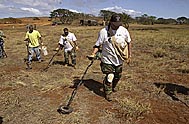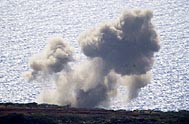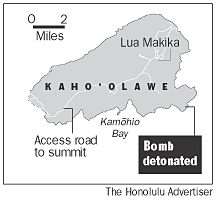By Timothy Hurley
Advertiser Maui County Bureau
HONOKANAI‘A, Kaho‘olawe — It’s a war out there and Johnathan Mateo is one of the foot soldiers. But instead of holding a weapon, he wields a high-powered metal detector in a team searching for unexploded bombs and shells.
 |
| One of the teams using metal detectors to locate unexploded ordnance on Kaho‘olawe included, from left, Kevin Cabrera, Daniel Lani and Kamaile Kimokeo of BioGenesis Pacific Inc.
Richard Ambo • The Honolulu Advertiser |
Mateo of Kihei, Maui, is proud of his role in the massive operation to cleanse the former military bombing range.
"It feels good," he said. "I’m a Native Hawaiian, and working out here is like cleaning up my back yard. You take care of the island and your people. That’s giving back. Some day my grandkids can visit the sites here to see how the Hawaiians lived."
Mateo and his comrades went public yesterday as the media toured Kaho‘olawe for the first time since the Navy launched the ordnance-removal project two years ago.
It was a wind-blown, dusty day not unlike most days on an island ravaged by decades of bombing practice and the erosion caused by unfettered grazing by goats. While there is a stark beauty, this is an island in desperate need of healing. Tires and old military equipment are found everywhere, and winds have swept away much of the island’s fertile topsoil, leaving many areas with an otherworldly Mars landscape with a bare hardpan surface.
In addition to demonstrations by teams engaged in myriad ordnance removal, cultural and restoration activities, yesterday’s tour also included the detonation of a 2,000-pound World War II bomb, the largest explosive device to be blown up by the Navy operation.
Officials with the Navy and the contractor, UXB-Parsons Joint Venture, took the opportunity to announce that a 400-acre section at Lua Makika, the island’s highest point and a culturally significant area for its agricultural importance, has been signed off as cleared of ordnance, the first section that will be handed over to the Kaho‘olawe Island Reserve Commission.
At the same time, however, they continued to point out that their efforts will fall short of original expectations that had them cleaning 100 percent of the island’s surface.
Navy Lt. Cmdr. Paul Borkowski said it now appears anywhere from 62 percent to 93 percent of the island will be cleaned by the time the project ends in November 2003.
Borkowski, the project’s operations officer, said that while those numbers may be disappointing, they are the best he can offer considering the financing and pace of operations. The project has received $240 million so far, he said, but there’s no guarantee it will receive the originally anticipated $400 million.
"I’ll tell you up front the Navy is very proud of what we’re doing out there," he said. "This is a complex task under tough conditions."
It is a war out there. Each day, a force the size of an Army battalion — 350 people — is mobilized from the operation’s off-island base at Kahului Airport.
 |
| Smoke billowed from the site where a 2,000-pound bomb was detonated by the Navy yesterday on Kaho‘olawe.
Richard Ambo • The Honolulu Advertiser |
"This is the largest UXO (unexploded ordnance) project ever undertaken by the Department of Defense," said James Putnam, the Navy’s civilian director. "(Military) regulars tell me they haven’t seen operations like this since Vietnam."
While it was slow going at first, the troops apparently are hitting their stride. Forty-five teams are sweeping the island, clearing 500 acres a month. Crews are battling high winds and steep terrain, while uncovering shells and bombs from all branches of the military and even some from other countries, which participated in joint operations. So far, they have gathered a million pounds of ordnance scrap.
"My feeling now is that morale is high and they’re seeing the fruits of their labor pay off," Borkowski said.
As for yesterday’s detonation, the blast went off as scheduled, sending a cloud of smoke into the sky at about 11:11 a.m.
While reporters who witnessed the event from a distance of 440 yards didn’t feel the explosion, the impact apparently was felt across the channel. Greg Kaufman, president of the Pacific Whale Foundation, said he and his research team felt the blast atop Pu‘uola‘i in Makena, Maui.
Kaufman, who previously lodged a protest about yesterday’s detonation, said the event proved his contention that it would negatively affect the humpback whales in the waters surrounding Kaho‘olawe. Kaufman said he observed eight groups of whales in the region at the time of the blast — all of which ceased normal surface behavior and apparently headed toward Ma‘alaea Bay before resurfacing at 11:42 a.m.
Navy officials, who acceded to Kaufman’s request to put a helicopter in the air to make sure whales were clear of the surrounding waters, said they didn’t believe the endangered marine mammals were affected by the explosion.
[back to top] |



